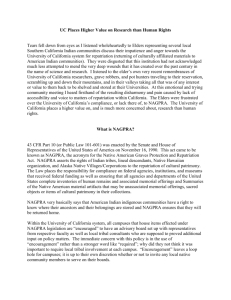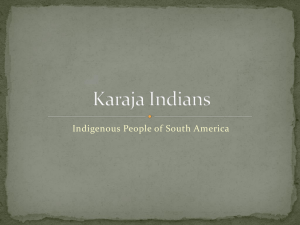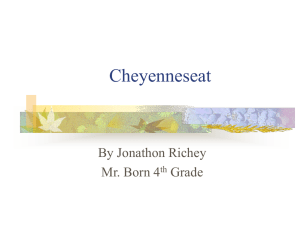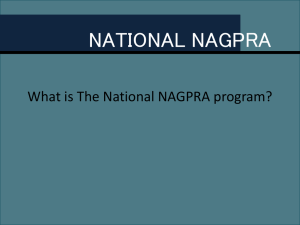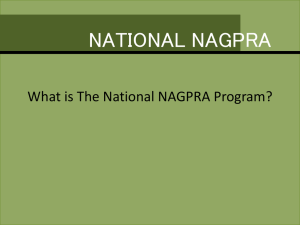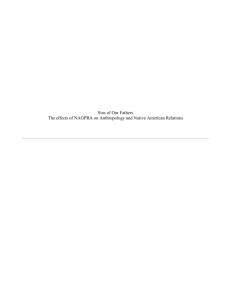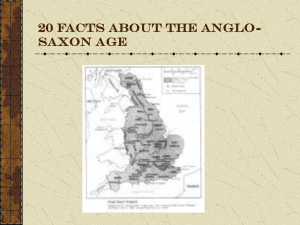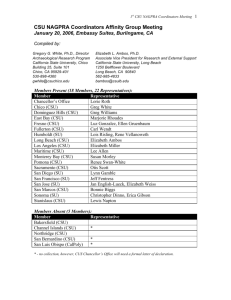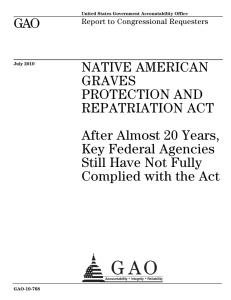SACRED LANDS WORKSHOP Laws and Policies
advertisement
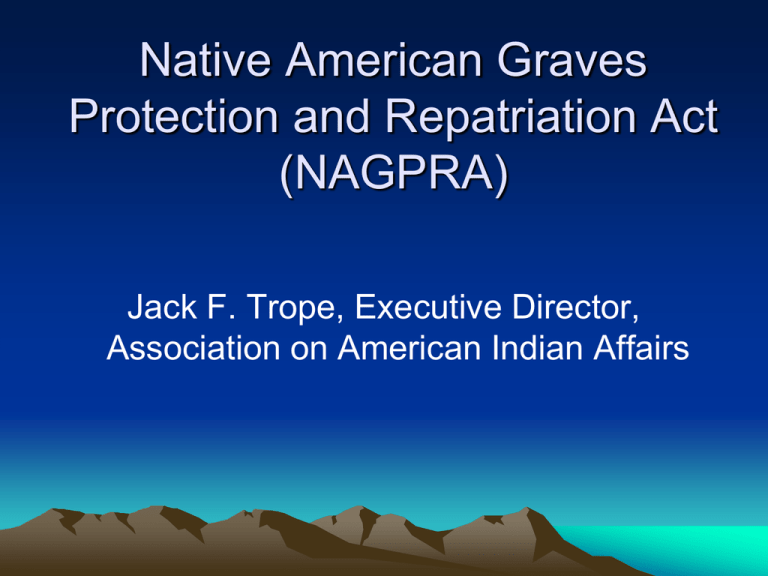
Native American Graves Protection and Repatriation Act (NAGPRA) Jack F. Trope, Executive Director, Association on American Indian Affairs NAGPRA • Applies in three contexts – (1) repatriation of human remains and cultural items from museums and federal agencies, (2) protection of burial sites and cultural items located on federal and tribal land, and (3) trafficking in Native American human remains and cultural items. NAGPRA – Legislative History • Human rights legislation • Based upon trust relationship • Compromise between museum, scientific, Indian communities NAGPRA – Who has rights • Lineal descendants • Indian tribes • Native Hawaiian organizations NAGPRA – Definitions • Associated funerary objects – Objects made exclusively for burial purposes or that are associated with specific human remains in the custody of the agency or museum • Unassociated funerary objects – Objects removed from a burial site where the human remains are not in the custody of the agency or museum NAGPRA – Definitions (cont.) • Sacred objects – Ceremonial objects needed for the practice of traditional Native American religions by present day religious leaders • Objects of cultural patrimony – Object having ongoing historical, traditional or cultural importance central to the tribe/culture and which was inalienable at the time it was separated from the tribe NAGPRA – Who Has Responsibilities • Museums – federally funded • Federal agencies (excluding the Smithsonian which is covered by its own law) NAGPRA - Responsibilities • Item by item inventory of human remains and associated funerary objects • Summaries of unassociated funerary objects, sacred objects and cultural patrimony NAGPRA - Repatriation • Human remains and associated funerary objects must be repatriated to direct descendants and culturally affiliated tribes • Cultural affiliation – relationship of shared group identity which can be reasonably traced between a present day tribe and an identifiable earlier group NAGPRA - Repatriation • Cultural affiliation determined through inventory/summary or based on evidence submitted by a tribe/NHO • Types of evidence may include geographical, kinship, biological, archaeological, anthropological, linguistic, folkloric, oral traditional and historical evidence NAGPRA - Repatriation • Recent regulations govern repatriation of human remains whose cultural affiliation cannot be determined. • Museum or federal agency must offer to return “culturally unaffiliated” remains if removed from tribal land or tribal aboriginal territory • Culturally affiliated tribes that are not federally recognized may repatriate if no federally recognized tribe who could make a claim objects NAGPRA - Repatriation • Repatriation of unassociated funerary objects, sacred objects and cultural patrimony – a 4 step process • 1. Show that the item meets the definition for one of the categories • 2. Show cultural affiliation or (in case of sacred objects and cultural patrimony) that the item was previously owned or controlled by the tribe or a member of the tribe (lineal descendants may seek return of sacred objects) NAGPRA - Repatriation • 3. Present prima facie evidence that the museum or agency did not have right of possession, i.e., did not obtain the items with the consent of an individual or group that had the right to transfer title. • 4. If prima facie case made, then burden shifts to museum or agency to prove it has the right of possession. NAGPRA – What types of sites are covered • Sites that contain human remains or Native cultural items • Cultural items include funerary objects (associated and unassociated), sacred objects, and cultural patrimony NAGPRA – Lands Covered • Federal lands • Tribal lands – defined to include all lands within reservation boundaries regardless of land ownership, all dependent Indian communities and lands administered for Native Hawaiians. • State land in one circumstance – land transferred to South Dakota in the Water Resources Act NAGPRA – Intentional Excavations • Tribal land – tribal consent required • Federal land – notice and consultation with tribe • Party must obtain an ARPA permit NAGPRA – Inadvertent discovery • Person who discovered the items must cease activity for 30 days, make reasonable efforts to protect the items discovered, and notify the federal agency (if federal land) or the tribe/Native Hawaiian organization (if tribal land) • When federal agency receives notice, it must notify appropriate tribe/NHO NAGPRA – Consultation procedures – federal lands • Notice must be sent to known lineal descendants, tribes/NHOs that are likely to be culturally related to the items at the site and tribes that aboriginally occupied the land; notice shall propose a time and place for meeting and include relevant information • Agencies should also seek to identify traditional religious leaders NAGPRA – Possible outcomes • Commentary to the regulations states that “in situ” preservation of sites should be considered wherever possible • But NAGPRA does not prevent excavation. • If excavation, ownership and control of the items can pass to descendants or tribe/NHO if legal criteria met; it not, becomes property of the United States NAGPRA – Action Plans • Where excavation is to occur, agencies must develop written action plans that include (1) information about kinds of objects considered cultural items, and (2) how custody will be determined and items disposed of, (3) how cultural items will be handled and analyzed and recorded (if applicable), and (4) how tribes will be consulted. NAGPRA – Ownership/Control Rules for Remains/Objects Unearthed on Federal/Tribal lands • Human remains and associated funerary objects: Lineal descendents • Unassociated funerary objects, sacred objects and cultural patrimony (or if no lineal descendents determined): NAGPRA – Ownership/Control Rules for Remains/Objects Unearthed on Federal/Tribal lands (cont.) (1) Tribe or NHO with the closest cultural affiliation, (2) The tribe/NHO on whose land the object or remains were found (3) Tribe that obtained an Indian Claims Commission or Court of Claims judgment recognizing the land on which the object or remains were found as its aboriginal land, unless there is another tribe with a closer cultural relationship. NAGPRA – Ancient human remains • Bonnischen v. United States, 367 F.3d 864 (9th Cir. 2004) • Interpreted statute to apply only to human remains and cultural items that “bear a significant relationship to a presently existing tribe, people or culture” • Not adopted by any other Circuit to date NAGPRA – Trafficking • Prohibits trafficking in human remains without consent of the next of kin, tribe or NHO • Prohibits trafficking in cultural items if obtained in violation of the Act NAGPRA – Review Committee • 7 member committee, 3 Native American (at least 2 traditional Native American religious leaders), 3 from museum and scientific community, 1 chosen by list compiled by the other 6. • Makes recommendations to Secretary on regulations, monitors inventory process, makes recommendations to parties in disputed cases, submits report to Congress. International Repatriation • Increased focus on issue by tribes • Right to repatriation recognized by the United Nations Declaration on the Rights of Indigenous Peoples
